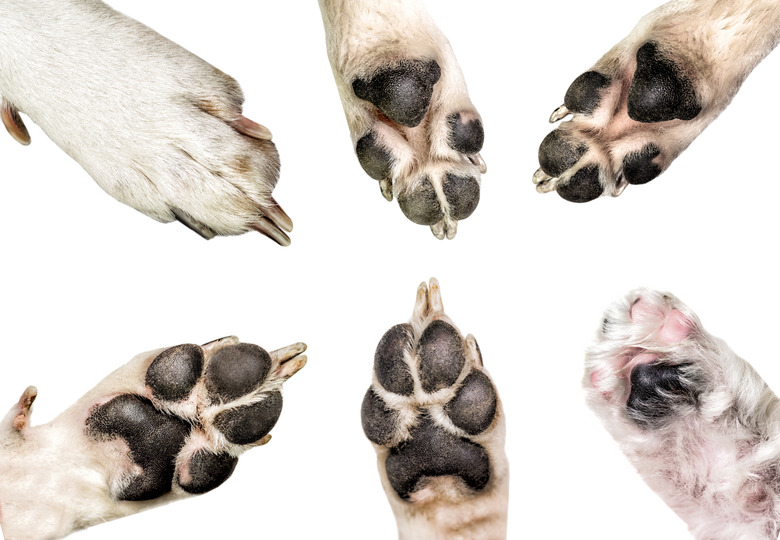Do All Dogs Have Dew Claws? Here's What Breeds Of Dogs Have Dewclaws
We may receive a commission on purchases made from links.
If you've ever examined your dog's paws or legs, you may have noticed a small, seemingly out of place claw that rests just above the others. This appendage is known as a dewclaw, and despite popular belief among some, it does serve a purpose. All dogs naturally have them on their front legs, but some breeds also have them on their rear legs as well, and some polydactyl paws are blessed with double dewclaws as well.
What is a dewclaw?
What is a dewclaw?
According to petMD, dewclaws are essentially the dog equivalent of the thumbs or big toes you would find on your own hands and feet. If you compared a dog's paws to a person's hand, the dewclaw would be easily recognizable as, much like a thumb, it is smaller in size and rests farther up on the paw. Dewclaws can be found on the front and rear legs of some dogs and have been passed down from early canines who relied on their dewclaws to help them grip on to certain surfaces. Today, dewclaws are still sometimes used to help your dog grab on to things the best way a dog can, whether that means gripping the ground as she makes a fast, tight turn or helping her hold on to a bone or stick that she's chewing.
Do all dogs have them?
Do all dogs have them?
All dogs are born with front dewclaws, says Dogster. If your dog is missing his front dewclaws, it is likely because they were removed by his breeder while he was young. More often than not, dewclaws do not bother most dogs and can sometimes be used by a dog when cleaning to rub his eyes or parts of his face. Some dogs are also born with rear dewclaws. Unlike the dewclaws on the front leg, which are affixed to the leg by bones and ligaments, rear dewclaws are only attached by a loose piece of skin, which can make them more prone to injury.
Because dewclaws don't always lay perfectly flush along the leg, they can sometimes present an opportunity for your dog to become injured, especially if he tends to get his dewclaw caught on things. While these injuries are fairly uncommon on front dewclaws, they can sometimes be a problem on the rear legs, especially if your dog is at risk of having them tear off, which can sometimes happen to dogs who engage in agility courses or activities.
Double dewclaw breeds
Double dewclaw breeds
In addition to an extra set of dewclaws on a dog's hind legs, some dogs are born with double dewclaws—two claws that sprout from that same spot. According to Chewy, there are several breeds that sport both rear and double dewclaws, including Portuguese sheepdogs, Icelandic sheepdogs, Saint Bernards, and briards, to name a few. Some breeds are required to keep their double dewclaws if they wish to compete in AKC dog shows, like Great Pyrenees and the Norwegian lundehund, the latter of which has six toes on all four feet, which were once needed to climb jagged rocks in search of puffin birds.
Is dewclaw removal safe?
Is dewclaw removal safe?
When done by a veterinarian, dewclaw removal is technically safe, although most people would agree that it's unnecessary unless, of course, your dog is suffering from a condition near the claw, like a tumor or chronic ingrown nails. As iHeartDogs explains, removing a dewclaw that's attached to the body by tendons can lead to atrophied muscles due to disuse over time. If your dog's dewclaw is only held on by a loose layer of skin, however, removal should not be nearly as traumatic. If you aren't sure how your dog's dewclaw is attached to her body, or if you are seriously considering dewclaw removal, consult your veterinarian for a professional opinion. As with any major decision you make about your dog's health, what you do will ultimately be up to you, hopefully with your specific dog's health and habits in mind.
Another thing to keep in mind regarding dewclaw safety is nail length, especially if you rely on walks on concrete to naturally trim your dog's nails. Like the rest of her toenails, the nail on your dog's dewclaw will grow, and if it's left unattended for too long, it can present problems. Unlike the rest of her nails, which grow downward due to the position of her toes on her feet, dewclaw nails grow alongside your dog's leg and can start to dig into the skin without regular maintenance. If your dog has front or rear dewclaws, always remember to check them regularly and trim them down to a healthy length to prevent possible injuries.
